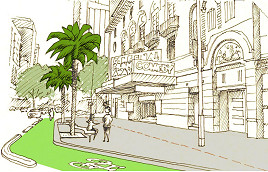Robbie Burns in St Kilda Rd
As you link arms and sing Auld Lang Syne this New Year’s Eve, you probably won’t bring to mind the legendary poet Robert Burns who died 226 years ago in distant Scotland never having visited Australia, which at the time of his death had been settled barely a decade.
Narrm was still undisturbed, except for the everyday activities of the Wurundjeri Woi Wurrung and Bunurong Boon Wurrung, the traditional custodians of the land we call Melbourne, people who had lived on this land for many thousands of years before white settlement, which was almost 40 years into the future when Burns died.
A few weeks later, on January 25, Scots around the world will celebrate Burns Night on the anniversary of his birth in 1759. Will you, too, consume haggis, neeps and tatties washed down with a dram (or two) of whisky, perhaps while listening to readings of one of his many poems and songs (think “O my love is like a red, red rose” and “Gin a body meet a body coming thro’ the rye”)?
From January 1904 until 1970, the imposing bronze statue of Burns you see here stood in St Kilda Rd, not far from Princes Bridge. It towered over a barely recognisable streetscape, arms folded, a larger-than-life figure imbuing a sense of strength and purpose in this relatively new (look how small the plane trees are) landscape.
It’s hard to believe that just over 50 years before this photograph was taken and a bit further down the road towards St Kilda, bushrangers bailed up and robbed a number of Melburnians on a sunny October afternoon. Then the road was little more than a dirt track to the seaside retreat of St Kilda, a dusty track in summer and a boggy mess when it rained. Soon, with the road surface laid, neat bluestone gutters in place and street trees planted, the streetscape began its transformation, although as you see here it was the trees that dominated the skyline, apart from the Burns statue, that is.
In this photograph the past and the future move alongside one another, the new-fangled car on the left passing the horse-drawn vehicle on the right. There’s not a tram in sight and there were no rules yet to say that cars had to drive on the left side of the road. Both vehicles are moving in the direction of the city and to get there they had to pass the present Arts Centre site, then the home of Olympia, the Fitzgerald Brothers’ (and later Wirth’s) Circus. Next to that was an amusement park known as Prince’s Court with its Japanese Tea House, open-air theatre, spectacular water chute and other forms of entertainment. Then they would move across the Prince’s Bridge to the city proper, past the site of the very new Flinders Street Station redevelopment (yes, they had big redevelopments then, too) and along Swanston St into the thriving business and commercial centre.
In 1903, when it was announced that the statue would be placed in a “pleasant and appropriate setting”, one newspaper came back with a quick rejoinder – “Appropriate – the jam factories, the smoke-stacks, the Yarra dredges!” Yet there is no sign of those symbols of industry here.
Looking at this tranquil scene … you could believe you are in the country, not metres away from a built up, noisy city environment. There are no overhead wires, no telegraph poles, no tramlines, the street lighting is unobtrusive. There is no Shrine of Remembrance in the distance. That was still decades into the future, in the aftermath of a war that would transform the world, not just Australia. After that war, Australia stepped firmly into the 20th century.
There is none of that here. The stillness of the scene, its restfulness, transports you out of time and place to somewhere where it possible to just sit and be, the protective gaze of a giant Robbie Burns looking over you.
Here you could believe you are sitting quietly listening to the “murmuring streams” of Burns’s poem about Afton Water.
There are no hills or valleys in the flat St Kilda Rd landscape, but here is the antipodean equivalent of the woodlands where his primroses blew and just across the road are vast parklands where every Melburnian could listen to birdsong, walk among nature and remember the places and people they had left behind. •

Council endorses office tower at Flinders Lane despite querying car park demolition






 Download the Latest Edition
Download the Latest Edition